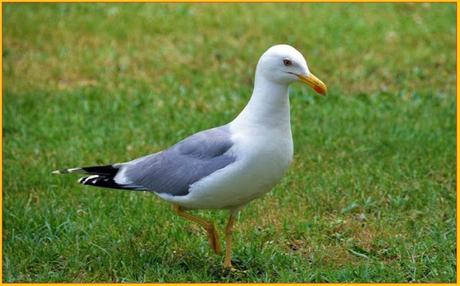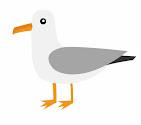Tamping is an unusual word, not to be confused with stamping, which is something much more violent. It means to press down gently but firmly, and is most commonly applied to the process of compacting tobacco in a pipe-bowl, ground coffee in an espresso machine, (you'll probably have witnessed this being done in any Costa, Nero or Starbucks), and the gravel that railway-lines are laid upon. But certain birds do it too, gulls in particular, on patches of grass. They do it rhythmically like a dance to fool worms into coming to the surface, for the tamping cleverly mimics the effect of rain falling and worms love a bit of moisture, just as gulls love a bit of worm.
Who knows how the gulls happened on the trick, for it is a learned behavior and I quite often see twenty or thirty gulls all doing the worm dance in my local Revoe Park or on the sports field behind the gym I attend. I find it an amusing and entertaining sight to watch them all tamping away.

doing the worm dance
For the most part it's Herring gulls (as above) who seem to do this. By the way, there is no such bird as a 'seagull'. That's just a lazy generic term that arose because gulls are most commonly found around coastlines. There are in fact fifty-four distinct species of gulls worldwide. About one third of those can be seen regularly in the UK: Black-headed, Bonaparte's, Common, Franklin's, Glaucous, Great Black-backed, Herring, Iceland, Ivory, Laughing, Lesser Black-backed, Little, Mediterranean, Ross's, Sabine's and Slender-billed gulls. You'd have to go further afield to find the following: Andean, Armenian, Audouin's, Belcher's, California, Caspian, Dolphin, East Siberian, Kelp, Lava, Olrog's, Relict, Saunder's, Sooty or Swallow-tailed gulls. Some gulls aren't even called gulls, but Kittiwakes. And some seabirds that are commonly mistaken for gulls are actually Terns, though they will also happily swoop and snatch food just as gulls are known to do.It appears that gulls go tamping more in the winter months than during the summer. That's possibly because the ground is drier and harder in summer and they have a thriving tourist population to keep them supplied with chips, fish, kebabs, pizza and sandwiches. Tamping is for when the going is soft and the pickings are lean!
As for that Big Birdwatch count, Adele and I spent a drizzly hour in Stanley Park this morning before breakfast where, in addition to several varieties of ducks, geese, gulls and terns on the lake, we also saw loads of coots and moorhens, several cormorants and a couple of herons. In the woods we spotted blackbirds, blue tits, chaffinches, crows, a flock of goldfinches, great tits, long-tailed tits, magpies, nuthatches, parakeets, robins and wood pigeons. In the hour we saw no sign of the coal tits, dunnocks, goldcrests, song thrushes, tree creepers, woodpeckers and wrens that are sometimes in evidence. Sadly, none of the gulls were doing the worm dance today, probably because it was already raining.Gulls TampingOff-season, hard of herring or chipsthese clever sea-birds each paddling
a square of turf for all they're worthlike Irish dancers -- all the action in
hips, legs and feet -- their tampingreplicates the rhythmic gentle thud of falling rain sufficiently to charm gullible worms up out of damp earth
two hundred per meter it's believedif they've stamina and greed enough.
If you'd like to see a pair of gulls in tamping action, here's a YouTube clip: Tamping Gulls

Thanks for reading, S ;-) Email ThisBlogThis!Share to TwitterShare to Facebook
